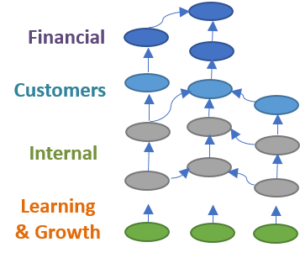In our previous blog post, "The Power of Employee Engagement", we looked at the empowering effects an engaged workforce has on an organization, looking at the crucial steps organizations should consider in implementing an effective engagement process. This week we ask you to consider your strategy and the high level objectives of your organization and how to effectively communicate these throughout your organization to drive results.
So, how do you get your strategy out of the hands of the leadership team and into the hands of the people who are responsible for delivering the plan on a daily basis? For us, it starts with creating your strategy map.
A strategy map is a one page story board that describes the theory behind how a company will achieve its goals and is based on the work of Robert Kaplan and David Norton, the architects of the Balanced Scorecard. It organizes a company’s strategic objectives across four perspectives:
- Financial
- Customer
- Internal Processes
- Learning & Growth
These objectives become the basis for establishing a measurement framework that drive shareholder value, customer expectations, critical business processes and organizational development. The context for each of these perspectives is established by answering the following questions:
- How do we need to look financially to lenders, shareholders and other interested parties? (Financial perspective)
- To achieve our vision, how should customers view us? (Customer perspective)
- To satisfy our financial stakeholders and customers what must we excel at? (Internal Process perspective)
- To achieve our vision how do we sustain our ability to improve and create value? (Learning & Growth perspective) [1]
The high-level objectives for each of these perspectives will come together to tell a story that communicates an organization’s strategy for achieving its goals.

As you can see above, the foundation of the story is the learning & growth objective. According to Kaplan and Norton, the learning & growth perspective of the strategy map should “define objectives for aligning the company’s human resources and information technology to its strategy and determine the culture needed to support the plan.” [2] Our focus in the learning & growth perspective is on developing an understanding of 1) what we need to do extraordinarily well to realize the full potential of people; 2) what behaviors should define the company’s culture; and 3) what role technology will play in the company’s success. Meeting our people, culture, and technology objectives establishes the foundation that enables the organization to excel at executing the internal processes that are the driving forces behind accomplishing the strategy.
Internal processes are the engines of value creation. These processes enable delivery of the organization’s value proposition, identified in the customer perspective of the strategy map, and gains in operational improvements that contribute to the achievement of financial objectives.
In our work with companies of varying sizes and industries, we have found strategy maps are an effective tool to:
- Capture and communicate the logic behind the company’s strategy and the leadership team’s thinking
- Show the cause-and-effect relationship between activities that support the strategy
- Develop a measurement framework that conveys the organization’s priorities
- Align business unit, manager and individual contributor activities to the bigger picture
- Keep the leadership team aligned and focused
It’s important to note that a strategy map is not intended to be an implementation plan. Its purpose is to communicate the company’s story about how it intends to be successful and serve as a reference point for determining measures of success and prioritization of activities.
The details behind the map’s implementation are captured in action plans that are built on classic SMART goals with clear ownership of responsibility for delivering the desired outcomes. Next time we'll discuss this as we take strategy maps a step further and discuss how to create a measurement framework for your organization which links to the strategy map objectives to measure success.
Sources
[1] Kaplan, S and Norton, P (1996) The Balanced Scorecard: Translating Strategy into Action. Harvard Business Review Press.
[2] Kaplan, R. & Norton, D. (1996) Using the Balanced Scorecard as a Strategic Management System. The Harvard Business Review.
%20Full%20Color.png?width=250&name=Aliniti%20plus%20Tagline%20(Registered)%20Full%20Color.png)